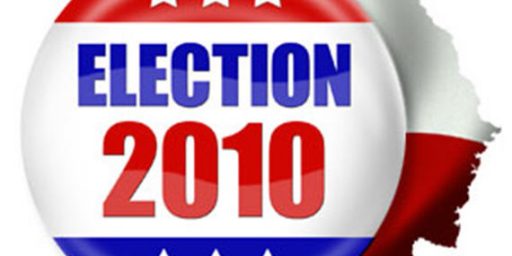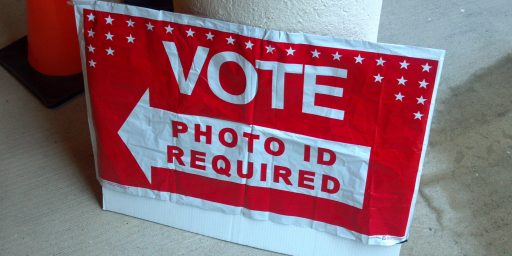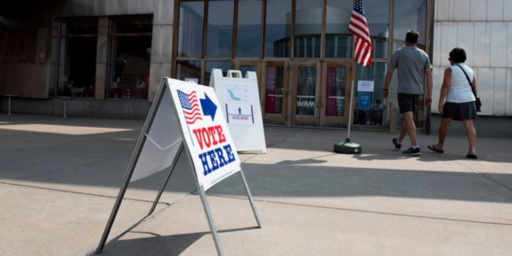A Cautionary Note About Polling Between Now And Election Day
Individual polls are likely to be volatile, so don't pay too much attention to them.
Several polls that have come out over the past couple days have drawn media attention, in no small part because they have been different in some way from what we’ve been seeing before. There’s been, of course, the SurveyUSA poll out of Kentucky purporting to show Alison Lundergan Grimes surging in Kentucky, Larry Pressler pulling into second place in South Dakota and, yesterday, a group of polls from Fox News that seem to be good news for Republican candidates and a CNN/ORC poll that seems to show Pat Roberts gaining ground on Independent Greg Orman in Kansas. Keeping all of that in mind, NBC’s First Read notes this important caveat:
Between now and Election Day, you’re going to see A LOT of divergent poll numbers. And the reason why is that not all likely voter models are created the same, even among good pollsters. We’re seeing more money being spent on turnout than ever before in a midterm cycle, but we’re also seeing American voters more turned off from the midterms than before. Those two things make polling more unpredictable. No one is confident who will be showing up to vote.
To emphasize that last point, a new Gallup poll that voter engagement is lower than it was during the previous two rounds of midterm elections:
PRINCETON, NJ — Turnout in the midterm elections this fall could be lower than in the past two midterm elections, based on current voter engagement. On each of three indicators of voter engagement in midterm elections — how much thought Americans have given to them, their expressed motivation to vote, and their enthusiasm about voting compared with past elections — 2014 looks more like lower-turnout years 1998 and 2002 than higher-turnout years 2006 and 2010.
The latest results are based on Gallup’s Sept. 25-30 poll, which includes updates on several key election indicators. Although voter turnout has not varied greatly in recent midterm elections — ranging from a low of 38.1% of eligible voters in 1998 to a high of 40.9% in 2010 — there is a positive correlation between greater voter engagement on these measures and higher voter turnout.
One likely reason voter turnout was higher in 2006 and 2010 was that Americans were deeply dissatisfied with the state of the nation, as well as the jobs the president and Congress were doing. In those elections, the same party controlled the presidency and both houses of Congress, so voters looking to change the government had a clear and obvious way to do so — voting against members of Congress from the majority party. And that is precisely what happened, with Democrats winning control of both houses of Congress in 2006, and Republicans winning control of the House of Representatives in 2010.
In 1998 and 2002, in contrast, Americans were generally pleased with the way things were going in the country and with the job performance of the president and Congress — even with divided party control — and were thus less motivated to use their vote to try to change the government. Accordingly, there was little change in the party composition of Congress after those elections.
This year presents a different set of circumstances. Americans are dissatisfied with the state of the nation and generally unhappy with the job the president is doing and even more so with the job Congress is doing. Earlier Gallup research suggested that low approval of Congress is associated with higher voter turnout in midterms. However, with a Democratic president and divided party control of Congress, there is no clear remedy to inspire voters to change things this year, and that may be keeping Americans’ motivation to vote and enthusiasm about voting in check.
The poll goes on to note that Republicans do tend to say that they are more engaged with the election than Democrats, which is typical of midterm elections and suggests that the GOP will maintain its traditional advantage. However, there does seem to be a clear lack of enthusiasm across the board regardless of party or demographic group, and that makes it harder for pollsters to figure out who might actually turn out to vote in November. It’s always a guessing game, of course, and how individual polling companies make that guess will heavily influence how their polls come out, but that guess becomes harder to make when it becomes less clear how likely people are likely to turn out to vote. If you get that guess wrong, then your polling isn’t going to be a very accurate reflection of either the current state of the race, or what is likely to happen on Election Day.
Because of this, the polling we see over the next month may be all over map, which of course will cause the cable “news” networks and political talking heads to react breathlessly with every development. Some of it may actually turn out to be a significant indication of the state of the race, but much of it is also likely to turn out to be noise that is best ignored. In that regard, it is good to remember that the final Gallup poll of the 2012 Presidential election had Mitt Romney narrowly leading Barack Obama, and that a Gallup poll from two weeks earlier had Romney with a seven point lead, As it turned out, of course, Gallup’s polling models for 2012 were completely off and it ended up showing up in the results. There were also many polls from other companies during the October 2012 timed period that purported to show the Presidential race tightening. In the end, of course, the President ended up winning by a comfortable margin. The point is that individual polls are likely to be all over the place, and they may not even be accurate. Rather than hyping each individual poll because it helps “your” candidate, if you really want to have some educated idea of what’s going on in the races for Senate and Governor, pay attention to the poll trackers at places like RealClearPolitics and Polltracker, along with the forecasts from Nate Silver, Sam Wang, Election Lab, and others. You’ll get a much clearer picture of what’s going on, and you’ll avoid the repeated cycle of excitement and disappointment that comes with each individual poll.







I always take the polling with a grain of salt.
The constant polling represents markers – a snap shot of where we are now, a few weeks in advance of the elections. Of course a lot can happen in the next 4 weeks, still, the polling just lets us know how the race is unfolding, and there is value in that (especially for junkies like me who follow this stuff.)
I’m not sure about this – are you indicating that polls become less reliable as they draw closer to the election?
Yes, Minister on polling:
http://www.youtube.com/watch?v=G0ZZJXw4MTA
@Pinky:
Not necessarily, but in this case there seems to be some doubt about what the Election Day electorate will look like in terms of things like gender, party ID, and race, and that because of that pollsters seem to be making a lot of guesses than they normally do. If those guesses are off, then the polling is going to be off.
@Doug Mataconis: Thanks for clarification.
So, does that mean you will limit your “new polling data” tweets to something like ten a day?
For a liberal, the good thing about all this uncertainty is that really, there should be not uncertainty about this election at all. A republican surge leading to a Senate takeover should be a lock, based on the fundamentals. That is still the likely result-but the Democrats still have a fighing chance of holding on to the majority. This is what the polls are telling us. A Republican mistake or two could make all the difference.
@stonetools:
You had better make sure that your Ativan prescription is filled before November 2nd. You are going to need it
A lot of these races still have some pretty big undecided numbers as well.
A new FOX poll in KY has 9% undecided…3 weeks from the election.
Make up your mind people!!!
I also read somewhere that FOX is using a really heavily weighted Republican turnout advantage. So that may skew the poll results.
@stonetools:
Truthfully, deep down in places that I don’t often talk about, the strategist in me hopes that the GOP DOES take control of the Senate.
Because I know that the 2016 Senate field is already heavily slanted towards the Dems, and the one thing that can really help them improve on those already skewed odds is for the GOP to spend the next two years going batshit Bircher far-right Ted Cruzin crazy – as only they can do. Think Kansas and NC, but on a national scale, and played out on a national TV screen.
I also know that, functionally speaking, they have no chance of achieving a super-majority, so they are limited by the filibuster and they are limited by the veto pen, so the only real damage that they can do over the next two years is to themselves and their party’s electoral chances in a presidential election cycle.
So, I see it thus: no real policy changes, and two years of sound bites & policy statements and far-right overreaching with which to soundly beat them about their little heads in 2016. Frankly speaking, it’ll be a gift.
@HarvardLaw92: Good point, and it’s not like President Obama was going to do anything productive with his last two years anyway. That ship has sailed.
People do one thing for polls and surveys. Then they will do things differently once they get in the voting booth.
Polls are becoming increasingly unreliable. You have an increasing number of people that only have cell phones – usually Democrats. Even among those who still have land lines only about 10% actually respond.
@C. Clavin: It’s possible that’s true. It’s also possible that you just fell for the “I heard a rumor that the polls are off and we’re going to do better this year than everyone’s saying” trap that you’ve been laughing about for two years.
Polling companies call cell phones.
I’ve had several call my cell phone (and if I have time I usually respond because I feel bad for the people making the calls).
I also don’t think that democrats are the only cell phone only people. We aren’t democrats and have been cell phone only for at least 8 years.
That said I think the real problem for pollsters is that most people don’t want to spend 10 to 20 minutes answering poll questions.
@Just Me:
I don’t participate in polls because I object to working for a profit making enterprise for free.